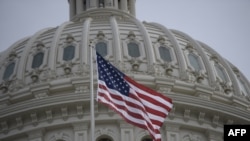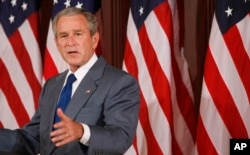A deadlocked Washington on immigration matters is not new. Congress' inability to address the legal status of undocumented newcomers and reform America's oft-criticized immigration system spans several decades and multiple U.S. administrations. Protracted gridlock helped spur the creation of Deferred Action for Childhood Arrivals, or DACA, as an executive order that bypassed Congress. The current political impasse has blocked a permanent legislative solution benefiting immigrants — sometimes called Dreamers — who were brought to America as children.
Key dates in recent efforts to reform U.S. immigration laws:
June 23, 2007: Then-President George W. Bush renews a call for lawmakers to forge a comprehensive immigration reform package, declaring, "The status quo is unacceptable." Neither house of Congress approves immigration reform during his two-term administration.
December 8, 2010: Majority Democrats in the House of Representatives pass the DREAM Act, which would grant permanent legal status to qualifying undocumented minors in America. The bill was derailed when it failed to get three-fifths backing in the Senate.
May 10, 2011: Then-President Barack Obama calls for an overhaul of America's immigration laws in a speech delivered in El Paso, Texas. Obama rejects calls from immigrant rights advocates to bypass Congress and unilaterally implement changes, saying, "That's not how a democracy works."
June 5, 2012: Obama unveils DACA, which allows undocumented immigrants who arrived in the United States before age 16 and have lived in the country for at least five years to obtain renewable two-year permits to work and study in America. Obama declares, "This is not amnesty, this is not immunity. This is not a path to citizenship. It's not a permanent fix. This is a temporary stopgap measure." Some 800,000 immigrant youth eventually enroll in the program.
June 27, 2013: The U.S. Senate passes a bipartisan immigration reform bill that would give millions of undocumented immigrants a chance at U.S. citizenship, force employers to verify the legal status of their workers, adjust criteria for legal immigrants coming to America, and dramatically boost U.S. border security. The Republican-led House of Representatives does not vote on the bill, which supersedes many DACA provisions, and it never reaches Obama's desk.
November 20, 2014: Obama expands on DACA with an executive order shielding many undocumented parents of U.S. citizens from deportation for renewable three-year periods.
November 25, 2014: Arizona Sheriff Joe Arpaio sues Obama over DACA and other executive orders. A federal judge dismisses the lawsuit a month later, as does a federal appeals court in 2015, saying Arpaio lacks legal standing. The U.S. Supreme Court declines to review the case in January 2016.
September 5, 2017: The Trump administration rescinds Obama's DACA executive order, effective March 5, 2018. President Donald Trump challenges Congress to enact a permanent legislative solution for young undocumented immigrants.
September 13, 2017: Trump discusses a DACA fix and enhanced border security measures with Democratic congressional leaders. A day later, Trump tweets: "Does anybody really want to throw out good, educated and accomplished young people who have jobs, some serving in the military? ... They have been in our country for many years through no fault of their own."
October 8, 2017: The White House issues its blueprint for immigration reform, demanding border wall construction, changes to legal immigration, and an end of so-called "sanctuary cities" that do not cooperate with federal authorities in identifying and handing over undocumented immigrants. Most Democrats reject the blueprint but, in the weeks that follow, do not follow through on threats to hold up federal funding extensions that fail to address DACA.
January 9, 2018: A federal court freezes Trump's order rescinding DACA, allowing existing beneficiaries to continue to renew work and study permits. On the same day, Trump holds an hourlong, televised bipartisan meeting with lawmakers on immigration. Trump expresses optimism a deal can pass Congress and pledges to sign it if one does.
January 11, 2018: Trump rejects an immigration compromise reached by six senators of both political parties. Some senators present at the meeting report the president used vulgar language to describe some impoverished nations.
January 19, 2018: On the eve of a federal funding deadline, Trump rejects a Democratic offer pairing a DACA fix with limited border wall funding. Hours later, most Democrats refuse to back a funding extension and the U.S. government partially shuts down at midnight. Federal operations resume three days later when a funding extension is approved after Senate Majority Leader Mitch McConnell promises floor debate and votes on immigration proposals.
February 15, 2018: The Senate rejects four immigration proposals, three of which contained a DACA solution. Trump's immigration blueprint and DACA fix receives the fewest votes of all.
February 26, 2018: The U.S. Supreme Court declines to immediately intervene on DACA, effectively keeping Trump's rescinding of the program on hold.
March 22, 2018: Congress passes yearlong funding with no DACA fix.
April 1-2, 2018: In multiple tweets, Trump repeatedly rails against illegal immigration and blames Democrats for Washington's failure to enact immigration reform.








